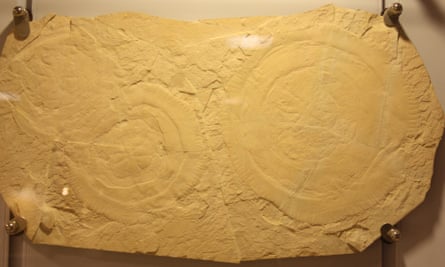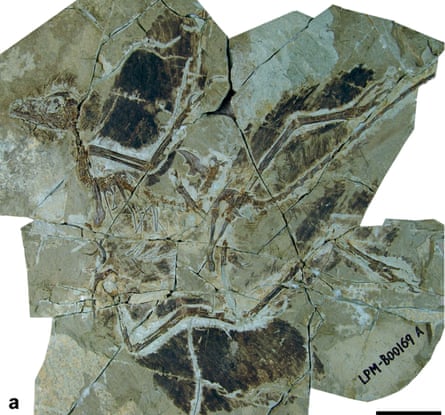Just in time for Halloween the news has broken that a fossil dinosaur brain (well, part of one) has been discovered in the UK. This is a truly remarkable find but in some ways not as exceptional as you might think. Certainly the fossil record is dominated by hard parts of animals (bones, teeth, shells, etc.) but the soft tissues (skin, muscles, and all manner of internal organs) do turn up from time to time and in quite a variety of different guises.

Such finds are incredibly important to palaeontology as inevitably there is a limit to what information can be extracted from bones alone. This can actually include plenty of information about soft tissues since there are some inevitable correlates at play – the eyeballs have to sit in the orbits, the brain inside the skull and so on. (As an aside many vertebrates have what is essentially a second mini-skull inside the head the encloses the brain so for example we know quite a bit about the size and shape of dinosaur brains from these). Bones also have scars on them where the tendons attached to hold muscles in place giving an idea of their size and how they operated the joints.

To go into greater detail though we really need some direct evidence of soft tissues and thus discoveries like the brain are therefore extremely informative. Some animals of course are made up of little more than soft tissues (there’s not too much that is very tough about the average jellyfish or octopus) so it’s not just about filling in details like the feathers on a fossil bird but can relate to entire organisms. We know that some groups are extremely ancient but have left almost no fossil record behind making it hard to say much about their origins or evolution.

A pair of rare fossil jellyfish from the Jurassic of Germany Photograph: David Hone
Ultimately it all comes down to the decay of tissues. The reason that bones, teeth and shells (and for that matter wood) are common as fossils is that they decay only very slowly. Carnivores and scavengers don’t tend to eat bones (and if they do, the bones might still survive the process) and bacteria don’t break them down effectively. As a result, they can hang around for decades or centuries and have greater opportunities to be buried and potentially turn into a fossil. Soft tissues tend instead to be eaten so would need to be buried soon after the animal died in order to have a chance to be fossilised (and even here the bacteria or fungi may get to them). A more effective method of preservation though is to be in an environment where decay does not tend to occur.

This can happen in a number of different ways, but ultimately it comes down to slowing or stopping the breakdown of the organic material. Very dry environments like deserts can lead to a form of mummification where the moisture is sucked out and nothing can digest the dehydrated remains. These animals can end up rather shrunken (like mummified humans from the deserts of South America) but it means plenty of soft tissues can survive and be preserved, especially if the skin was still present to hold them intact. There are even a few dinosaur mummies like this where muscles and even internal organs are preserved, though it’s rather hard to get to them without damaging the outer layers and CT scanners big enough to take a whole dinosaur are few and far between.
Rather more common are those that are in water but in conditions where bacteria are limited because of the water chemistry or lack of oxygen. Peat bogs are a favourite here though most things preserved in them are, although ancient, not fossils. This may however be the origin of the dinosaur brain – effectively pickled in the acidic peat waters and then later fossilised. Similarly, animals like mammoths frozen in the permafrost of Siberia are not actually fossils but the lack of decay means they preserve animals right down to their last meals still in their stomachs. Anoxic (oxygen free) waters can also be good for this and many of the spectacular feathered dinosaurs finds are from these kinds of conditions where the presence of fine volcanic ash in the waters also helped bury bodies quickly and with great fidelity producing some incredible finds.

A specimen of the non-avian dinosaur Anchiornis with the feathers preserved as black stains on the rock Photograph: University of Bristol/PA
Finally, some things can be preserved in amber. Glued into tree sap that then fossilised, there’s no possibility of decay and whole animals (even quite large things like lizards) and even spider silk can last tens of millions of years like this.
Even without these forms of preservation, soft tissues can still sneak into the fossil record as impressions. Footprints will often be clear enough to show the pattern of soles of animals’ feet, including the sizes and shapes of any scales or pads. Things like feathers or the membranous wings of pterosaurs may decay, but not before they have left an impression of where they were. Some of these can be very detailed (the feathers on Archaeopteryx for example are actually mostly impressions and not fossilised feathers) and provide a great deal of information.
Despite all these routes to preservation, the fossil record (and more recent things like ice mummies) remain rare for extinct animals. However, they are not vanishingly rare as many might think, and in particular some areas are producing huge numbers of preserved animals with various soft tissues intact. These might not always be in the best condition and examining or interpreting them may be difficult, but even a patch of skin or a bit of a brain has enormous potential. Plenty of contentious areas have been resolved from such finds as well as opening up new areas of research (like the colours of extinct animals) and they promise much for the future and so the excitement around even partial finds.